Subscribe Our Newsletter
Get the latest news, offers and inspiring travel stories straight to your inbox.
.jpg)
The most followed trek destination in Nepal is the Annapurna base camp. This amazing trek will take you to the majestic Annapurna region of Northwest Nepal. Trekkers will witness some of the most spectacular landscapes, offering breathtaking vistas and amazing cultural experiences. Compared to Nepal's other high-altitude treks, the ABC trek is a very simple and quick journey. Markedly, this journey is considered to be successful in attracting tourists from different parts of the world. The vistas of Mt. Machhapuchhre, Hiunchuli, the Annapurna massif, Baraha Sikhar, Nilgiri South, Tukuche, and Dhaulagiri are the main draw of this Trek. You will follow through the thick Rhododendron forests, Deep gorges, rivulets, eye-catching valleys, and diverse culture and tradition of Gurung, Magar, and Thakali whilst encountering a picturesque scene of mountains.
The trek can also be extended for a scenic hike to the village of Poonhill, known for its stunning views of the Himalayan range, including the spectacular peaks of Annapurna I, II, III, and South. Embark on an exciting journey to Annapurna Base Camp and unveil the mysteries of the Himalayas. Follow this complete guide to enjoy the beautiful scenery and diverse culture that Nepal has to offer. Discover how a challenging trek can lead you to captivating views of some of the world's most iconic mountains, and find out how you can prepare for this unforgettable adventure.
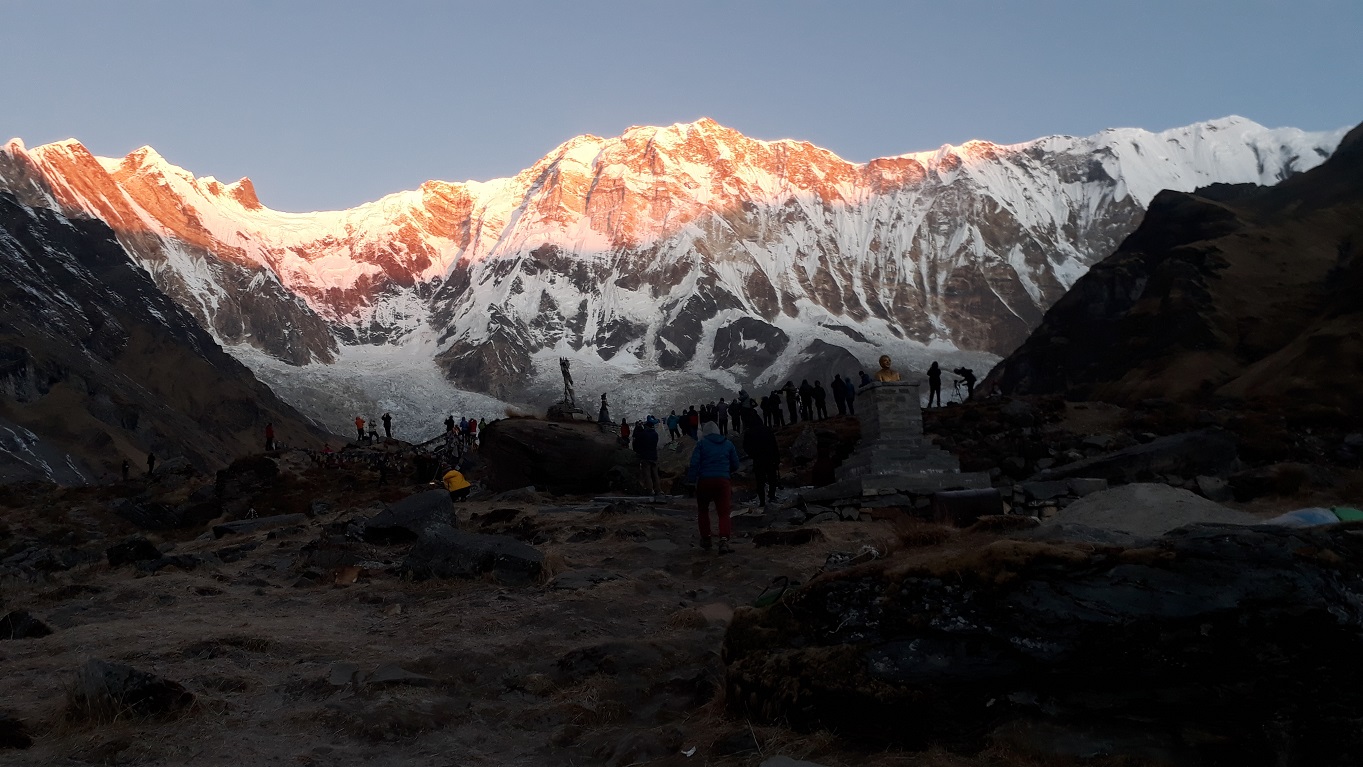
There are numerous ways to go to Annapurna Base Camp. Nearly all routes come to an end at Chomrong. It is the only way to go to base camp. After starting the trek can deviate to Ghorepani Poon Hill, deviate to Ghandruk upon your will, or both to reach the Annapurna Base Camp. You can pause while ascending and stop while returning in several locations. A typical 14-day trek to Annapurna Base Camp itinerary is provided below.
|
Day |
Activity |
Distance |
Elevation |
|
1 |
Arrival in Kathmandu |
- |
1400m |
|
2 |
Kathmandu to Pokhara |
- |
950m |
|
3 |
Drive to Nayapul Trek to Tikhedhunga |
15km |
1450m |
|
4 |
Trek to Ghorepani |
10.5km |
2874m |
|
5 |
Morning hike to Poonhill (3210m)to Tadapani |
10km |
2610m |
|
6 |
Tadapani to Sinuwa |
11.5km |
2340m |
|
7 |
Sinuwa to Deurali |
11km |
3230m |
|
8 |
Deurali to ABC |
9km |
4130m |
|
9 |
ABC to Bamboo |
16km |
2050m |
|
10 |
Bamboo to Jhinu Danda |
12km |
1700m |
|
11 |
Jhinu dada to Nayapul to Pokhara |
13km |
820m |
|
12 |
Drive back to Kathmandu |
|
|
|
13 |
International Departure |
|
|
-
A typical 7-day route includes a trek to ABC for those who don't have enough time to trek for 14 days.
The Annapurna Base Camp trek takes between 8 and 10 days. Depending on your level of experience, group size, and other various factors it can take longer. The normal trek distance to Annapurna Base Camp is 110 kilometers. You will need to trek for 6 hours on average every day, covering a distance of ten kilometers. However, there may be days when you must walk a little bit more or a little bit less than usual. This trail will take you through a rural area which will be a little bit difficult. Hence, for trekkers with a limited amount of time, this trek is an excellent option.
While it can be completed in any season, it's always good to get all the necessary information beforehand. Planning when to go for the Annapurna Base Camp trek is essential as this trek is a high-altitude trek. One must be aware of the potential risks of the seasons. In Nepal, there are six seasons: Spring (March-May), Monsoon (June - August), Autumn (September - November), and Winter (December - February). The best time to go on this trek is during the spring and autumn seasons. This is the time when you'll get the best view of the majestic snowy peaks while still having moderate weather which won't hinder your journey.
Springtime (March to May) is the best time for trekking since the skies will be clear, affording stunning views of the Himalayan peaks. Additionally, this season brings vibrant wildflowers blooming in the landscape and increased mountaineering activities. This season offers a more pleasant and balanced temperature with fairly low precipitation levels.
Autumn season (from late September to mid-November) is the most recommended season to go on this trek as the Nepalese Himalayas tend to be milder than other seasons. You will also be able to see the imposing snow-capped peaks that are spread over the canvas of the blue sky and the colorful vegetation that covers the landscape. The fresh days and crystal-clear mountain views are at their finest during this season.
Considering the monsoon season, the route is frequently muddy, slippery, and challenging to travel due to the constant rain throughout the monsoon. The vistas of the mountains and surrounding areas are thus less pleasant than they are in the fall and spring. It will get quite cold and snowy if you choose to travel during the winter, but you can anticipate a clear sky and decent visibility. Trekking in the winter season is fun if you appreciate the excitement of traversing the snowy trails. Hence, this trek can be also carried throughout the
winter and the monsoon seasons, but you must have the right training, be well-prepared, and have a low expectation of witnessing mountains with a good view.
This trek can be graded as easy to moderate depending on several factors such as trekking days, highest elevation, season, and route. Even though it isn't as physically demanding as other treks in the Himalayas, it's still important to make sure you're reasonably fit for it. It will be one of the most rewarding trekking experiences for those who are correctly prepared for it. The trek entails 6-7 hours of hiking each day, which includes steep ascents and descents, tight paths, riverbanks, straight trails, and occasionally there are even slick and snowy trails on the trail. Regular cardio exercise, running, jogging, and strength workouts for a few weeks before setting off on the trek are great ways to increase your stamina and prepare you for the journey ahead.
Beginner trekkers can easily conquer the Annapurna base camp trek as long as they are properly guided through knowledge and understanding of mountain environments. Those with hiking experience will have an easier time completing the trek since it won't necessarily require additional climbing or mountaineering techniques. You will climb over 4,000 meters on the Annapurna Base Camp trek. Therefore, taking preventive steps like drinking enough water, eating a healthy diet, rising gradually, etc., is important in this trek to prevent altitude-related issues like shortness of breath, dizziness, and headaches.
The Annapurna region features a variety of tea houses in higher altitudes and hotels/guesthouses of varying quality in the lower parts. These accommodations offer varying room types, ranging from private twin beds to dormitory-style rooms that can house up to six people. You can expect these rooms to cost from Rs 1500-2000 on these lodges. Despite their size, these lodges are known to be cozy and well-kept. While the majority of lodgings provide common toilets and restrooms, some offer attached bathrooms. Some places offer hot showers, but trekkers may always request a bucket of hot water which will cost some extra money.
The meals served on the Annapurna Base Camp Trek are comparable to those on other well-known trekking routes in Nepal. It is the least expensive item on the regular menu and is popular with both locals and visitors. Furthermore, there is an array of food options such as eggs in different styles, tortillas, cereals with milk, sandwiches, and potatoes cooked in various ways.
You can also expect noodles, dumplings, Macaroni, and Pancakes. Also, there are hot drinks available such as tea, coffee, juice, and flavored drinks. It is not advisable to consume alcoholic beverages during the trip, as it can make you more susceptible to acute mountain sickness (AMS).
We advise you to carry food items like protein bars, cheese, almonds, chocolates, and other snacks. These are calorie-rich and may be eaten while walking and helps to keep energy level maintained. In the case of water, it is available in bottles while trekking, but the prices increase with altitude. To save on budget and cut down on waste, having water filters or purifying tablets is preferable to buying bottled water throughout the route.
Permits are required for trekking to Annapurna Base Camp. Trekkers must obtain permits from the authorities before starting their journey. Tourist visas may also be needed, depending on where you are coming from. There are two permits needed for the Annapurna Base Camp trek.
You will require the TIMS (Trekkers' Information Management System) card and ACAP (Annapurna Conservation Area Permit). To get the TIMS card and ACAP card, you must fill up and submit the TIMS application (Trekker's Information Management) and ACAP (Annapurna Conservation Area Project) Permit application.
Entry Fee for ACAP: Rs 200
TIMS Card Fee: Single trekkers pay $20 whereas group trekkers pay $10.
Entry Fee for ACAP: Rs 3000 (23USD)
TIMS card Fee: Single trekkers pay $20 whereas group trekkers pay $10.
You should have both the ACAP entrance permit and the TIMS card while on the trek since they are both active for entrance into the area. These admission permits are not refundable and cannot be transferred. Both of the permits are available at the TAAN office in Pokhara and Nepal. Tourism Board office in Kathmandu.
Annapurna base camp trek is a thrilling and the most satisfying trek in the Himalayas. Over the course of more than a week, you will need to trek for about 5 to 6 hours every day while carrying a big load. To make your journey easier, you must think about the Annapurna Base Camp trek packing list before you begin to pack.
The following is a list of basic necessities that you should bring in your bag. The list is optional. It may be modified to fit your specific requirements.
Consider the season you'll be trekking in while choosing your clothing. Warm clothing is
necessary for the cold. You'll need rain gear during the monsoon. Wearing layers will allow you to remove the outer layer when you become heated and start sweating.
Here we have listed some of the clothing:
Particularly at higher elevations, the teahouses have few or no regular shower or bathing facilities. Therefore, it's crucial to maintain your personal hygiene while on this trek. Daily personal hygiene is a necessity that cannot be neglected. If you become sick, your journey will be halted. Here are some of the necessary toiletries and hygiene items
Documents
You will need the TIMS Card and the ACAP permit for the Annapurna Base Camp Trek. On the journey, there are several checkpoints where you must show your trek permits. As a result, you should carry them with you on the journey.
The following list of papers must be with you throughout all time while on the trek.
It's optional what you put in your backpack. You are the one trekking. Consequently, you might require a few more goods for yourself. Here is a rough list of extra gear and items you might need for your trek to Annapurna base camp.
You will need a backpack that is a decent size for fitting all of your goods inside of it. Anything between 30 and 55L would Be ok. Make sure all of your things fit in before making the purchase. Pick a backpack with comfortable back support and one that is easy to carry.
Getting travel insurance is crucial whether trekking or going in high elevations. Travel insurance should cover all additional costs that may be incurred as a result of various health problems, accidents, or injuries. You will want sufficient insurance that covers medical expenses as well as helicopter rescue and evacuation at the highest trek heights above 4000m. You will be hiking far from any roadways in very off-the-grid areas. In such cases, a helicopter is the sole means of transportation that can get people to safety. Thus, insurance could be perfect for you if you unluckily experience any kind of repercussions. We advise all visitors to purchase travel
insurance before departing for Nepal for trekking and other adventurous activities since it prevents them from having to pay a large amount.
The Annapurna base camp trek is a popular trekking route in Nepal. The trail passes through several different ethnic settlements, and the main language spoken by the locals is Nepali. However, there are also many local dialects of other languages such as Magar and Gurung which vary based on the region that you are in. While knowing some Nepali phrases may be helpful, many local people also understand basic English. Apart from that Hindi can also be used to communicate with people you meet along your journey.
Annapurna Base Camp Trek offers trekkers the convenience of having access to the internet, electricity, and mobile network. You may use Wi-Fi at the lodges where you'll be staying. However, As you reach greater heights they may charge you anything from 100-200 hundred rupees for each hour of use. However, its quick connectivity and availability are uncertain. You may call abroad using a Nepali SIM card. Calling from outside of Nepal might cost a bit extra, but you can still stay in touch with your loved ones while on the trek. Also, be aware that you may not get a strong network connection in every place on this trek.
Electricity is available during most of the trek, although as you ascend higher some places charge you some extra rupees for charging the electronic devices. However, it's important to bring extra batteries for your electronic devices. As long as you ascend higher you will find out those facilities getting hesitant.
The ABC trek price is determined by the number of days, travel season, guides, porters, mode of transportation, lodging, meal quality, group size or solo trip, and route. On average, the entire journey lasts around 8-10 days and the cost ranges between 1000 USD and 1500 USD. With a Special discount, we are offering this trek package for you at just 775 USD.
This takes into account all transportation, permits, meals (full board), a guide, a porter, and accommodations. Finally, if you decide to bring along your friends with you on this trip, you can take advantage of attractive discounts for bigger groups. The cost of the journey depends largely on whether you choose a private or group experience. Going with a group means sharing porters, guides, and accommodation throughout the trek - often resulting in a more economical option. you can also customize the itinerary and make changes to the package.
The trek to Annapurna Base Camp will undoubtedly be a memorable experience, full of breathtaking landscapes, fascinating people, and enchanting exciting adventure. Anyone who has the right mindset and has done some preparation can finish this trek. By picking the correct time, you must decide on your own level of difficulty for the Annapurna Base Camp trek. You may decide which of the many factors will influence what kind of your trek will be. With us, you can be confident that all of your trekking adventures will be exciting, memorable, and safe. You may get in touch with us whenever you need professional advice or help to manage your journey.
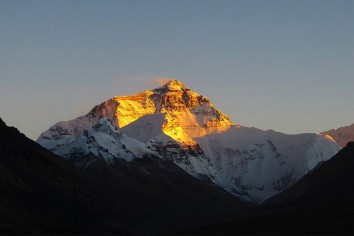
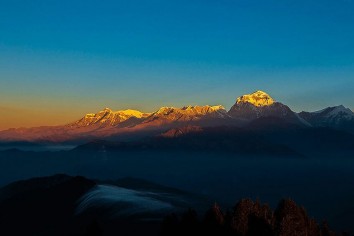
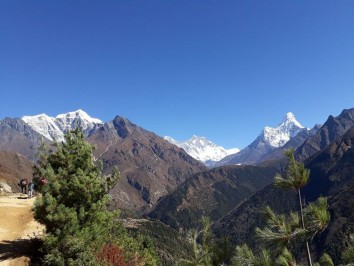
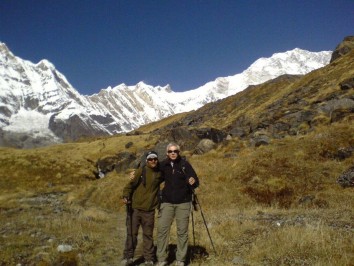
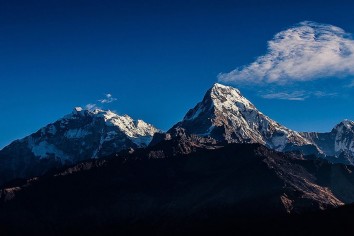
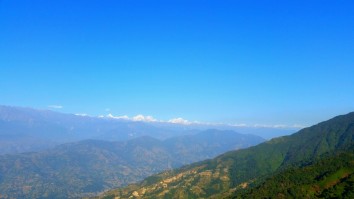
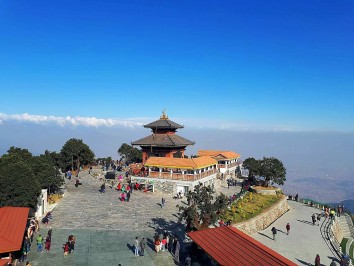
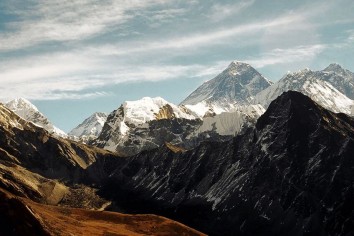
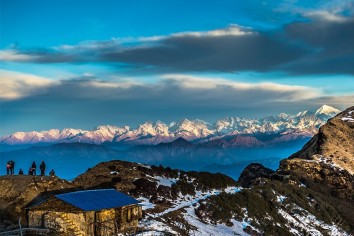
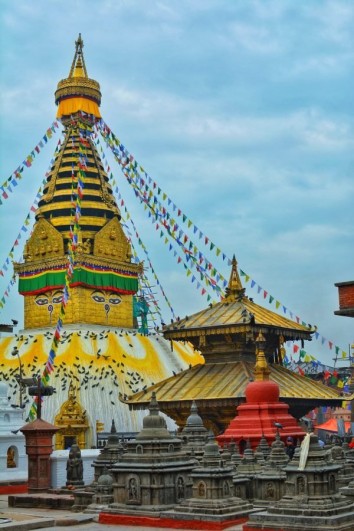
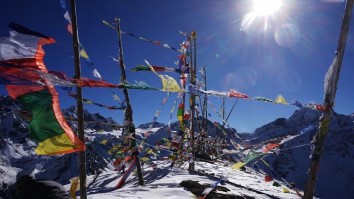
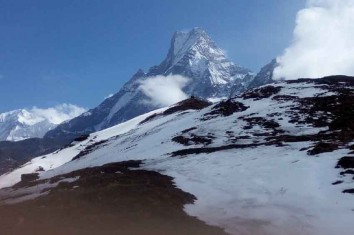
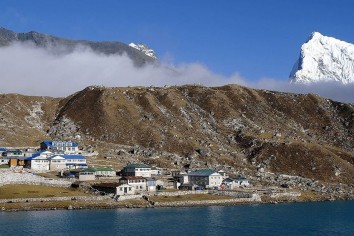
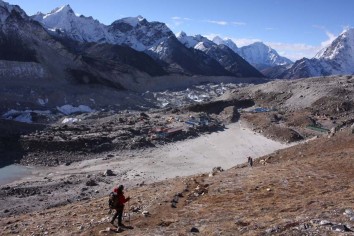
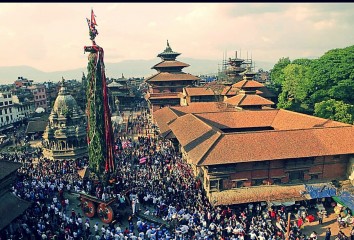
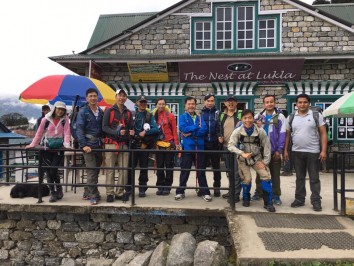
.jpg)
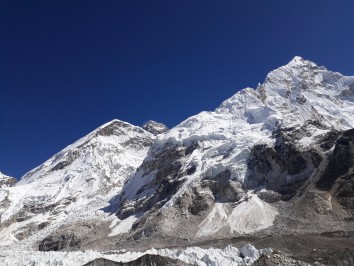

Get the latest news, offers and inspiring travel stories straight to your inbox.
© 2011 - 2024 All rights reserved. Team Himalaya Pvt Ltd. Developed By: Xenatech Nepal.